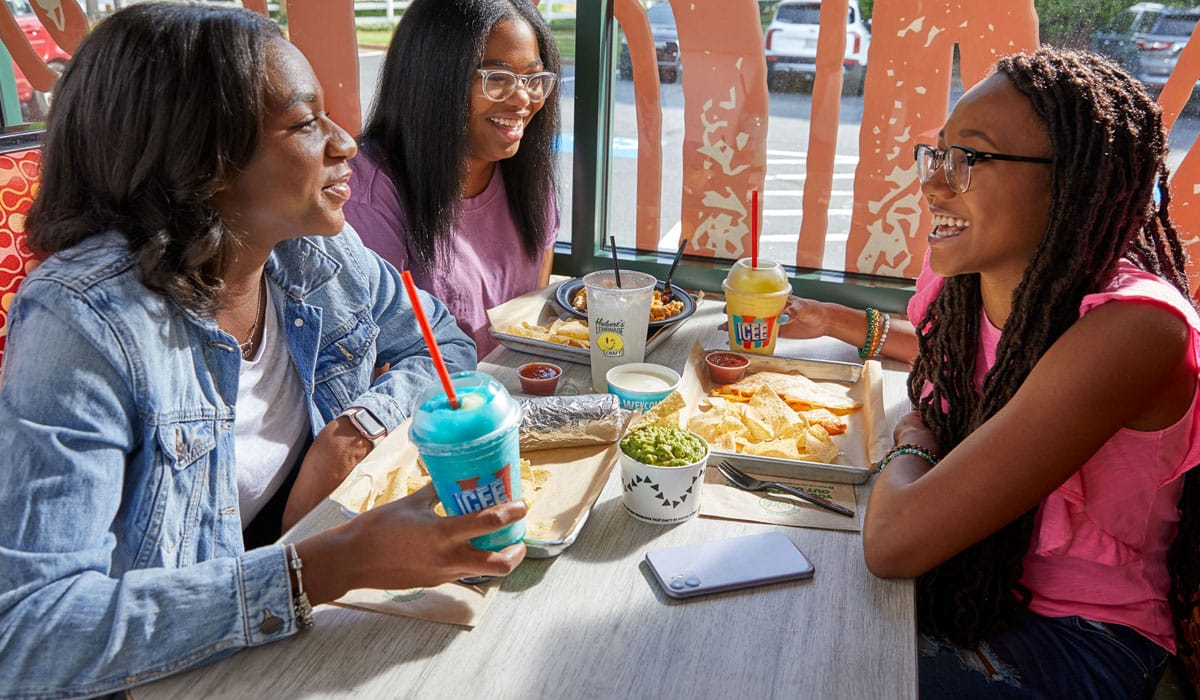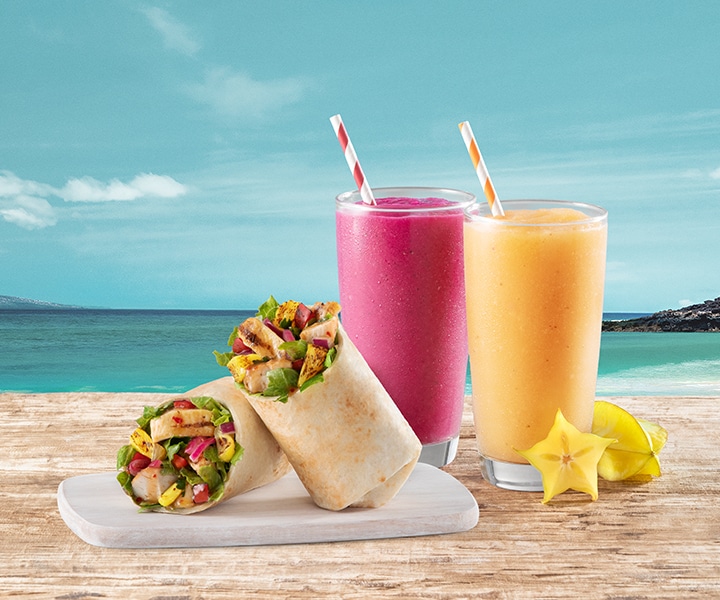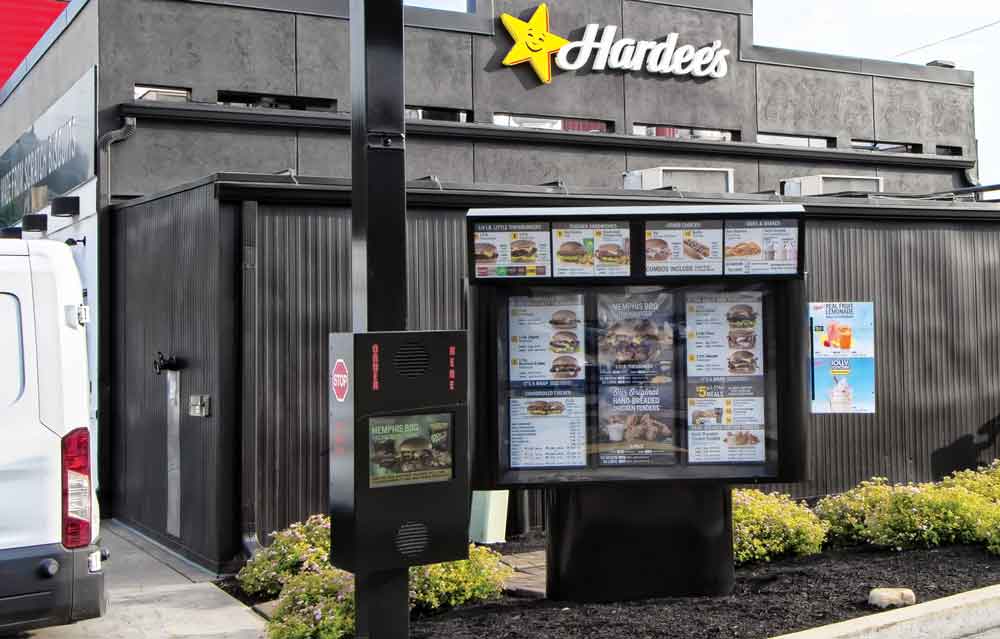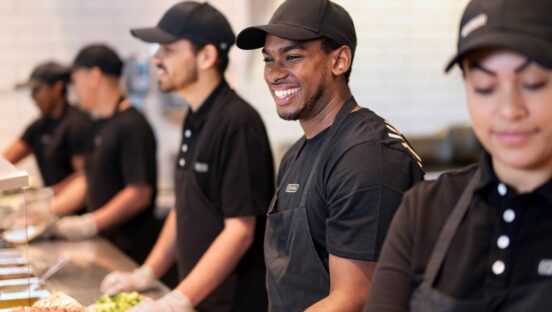Matthew Walls has a confession. For years, CKE Restaurants, the parent company of the well-known Carl’s Jr. and Hardee’s quick-service brands, built the restaurants it wanted to build. While consumers were certainly considered, stores were largely designed and constructed to meet the company’s purposes.
But that philosophy ends this summer with the debut of a new Hardee’s restaurant prototype in Nolensville, Tennessee. At 2,500 square feet, the upcoming unit shrinks the traditional Hardee’s footprint more than 25 percent, while 22 interior seats come in well below the norm.
The Nolensville Hardee’s serves as a prelude to bigger changes afoot at CKE. In next-generation store designs from the Tennessee-based restaurant enterprise, Walls teases multiple drive-thru lanes, a walk-up window devoted to third-party delivery, and a redesigned kitchen focused on optimization with new equipment, technology, and layout considerations.
“As guests become savvier and there are more options available, it’s more important than ever to listen to their voice,” says Walls, CKE’s global chief development officer. “We had to stop the way we were developing to best meet guest expectations.”
And CKE is far from alone.
Across the U.S., quick-service brands are aggressively altering store designs to accommodate shifting consumer preferences, so many powered by the COVID-19 pandemic. In TD Bank’s 2021 Restaurant Franchise Pulse survey released earlier this year, 55 percent of restaurant operators said they planned to add more space for pickup orders, while 45 percent were plotting additional drive-thru locations, and another 43 percent were looking to add outdoor dining space. Those figures underscore the fast-changing world of restaurant design.
As quick-service brands hustle to fulfill guest demand for contemporary, convenient, and safe experiences, store models are evolving at a rapid pace. To capture results and ensure long-term viability, today’s restaurant prototypes are imaginative, progressive, and forward-thinking concoctions incorporating once-unthinkable elements, such as interiors eschewing dine-in capabilities, drive thru-only stores, and triple-lane drive thrus.
“No customer, no revenue,” says Sam Ballas, founder and CEO of North Carolina-based East Coast Wings & Grill. “You either figure out how to shift your lens or you miss out.”

First and foremost, small is now BIG
Above all, the quick-service restaurant of the future is smaller. With lingering anxieties about dining in and a surge in off-premises orders, quick serves are slicing their traditional footprints to accommodate new and projected realities.
“We don’t need to build a 4,000-square-foot restaurant in an area in which we’re doing 95 percent drive-thru business,” CKE’s Walls says.
Smaller stores generally reduce construction time and expenses before shrinking occupancy costs. This positions brands, especially franchised concepts, to capture a lower investment cost while heightening ROI potential.
The conventional store at upstart Florida-based chain Chick’nCone covered some 1,200 square feet and featured about two dozen seats and an exhibition kitchen—the aptly named waffle theatre. Today, the brand touts a new 360-square foot shipping container prototype entirely devoted to off-premises traffic with a walk-up window and drive-thru lane. Two such units are already operating in Dubai, while the chain’s first such domestic unit will open this summer.
Compared to the company’s conventional restaurant design, Chick’nCone CEO Jonathan Almanzar says this new prototype slices upward of 40 percent off the costs and time needed to open the unit.
“You can’t argue with those numbers,” he says.
Mexican chain QDOBA, meanwhile, historically favored units of 2,400–2,600 square feet. With its new store prototype, however, it is reducing square footage about 20 percent to 2,000–2,200 square feet.
Notably, the push toward smaller-format concepts focused on off-premises orders is also being adopted by traditional full-service restaurant brands as well, which injects added competition into the quick-service marketplace. TGI Fridays’ “Fridays on the Fly,” for instance, is a 2,500-square-foot space with limited indoor dining and a hefty focus on processing takeout and delivery orders. Full-service giants like IHOP and Buffalo Wild Wings have similarly unveiled prototypes with reduced store footprints as has Ballas’ East Coast Wings. From the 4,500-square foot box it once inhabited, East Coast Wings now features a 2,100-square foot space with fast casual-like elements such as counter ordering.
“The smaller box size equals a reduced investment without a significant falloff in revenue,” Ballas says.

Who needs a dining room?
For years, fast-casual concepts like Panera and Starbucks fashioned themselves as a “third place”—a venue in which individuals could chill beyond their home or office. Many quick-service restaurants in small towns similarly celebrated their status as a hang-out spot.
The pandemic, however, battered the “third place” notion and prompted restaurant brands to question the need for indoor dining. Deloitte U.S. restaurant and food service leader Jean Chick says restaurant quick-service dining rooms are going to shrink and, in some cases, disappear.
“I wouldn’t be surprised if we see more and more quick serves close dining rooms altogether and move entirely to drive-thru and pickup-only footprints that offer the ultimate in convenience,” Chick says.
Indeed, prominent brands like McDonald’s, El Pollo Loco, and Jack in the Box have all unveiled prototypes reducing, if not wholly eliminating, indoor seating.
With Chick’nCone’s to-go and online ordering up 300 percent in 2021 and dine-in traffic trailing off, Almanzar says the value of a dining room declined, which is why his brand’s new prototype ditches indoor seating in favor of a walk-up window and drive-thru. Yet more, eliminating the dining room allows the growing chain to be more efficient with its human capital, thereby addressing another pesky challenge in the restaurant space.
“It makes more sense to remove the dining room element and focus on the kitchen,” Almanzar says.
Many brands, however, are offering a compromise to those who still want to dine on-site or hold anxieties about inside dining by delivering outdoor patios. Prototype renderings from the likes of KFC, Sweetgreen, Smashburger, and Pokeworks all include extensive patio seating.

Not your father’s drive thru
In today’s quick-service environment, a drive-thru is a virtual necessity to accommodate guest demand for convenience and safety. It’s why so many brands that went years without drive-thru restaurants—Shake Shack, Chipotle, and Sweetgreen among them—are racing to service vehicle-bound customers.
At the minimum, a single drive-thru lane is key, though recently unveiled quick-service prototypes are reaching beyond that standard with additional lanes designed to reduce wait time and accommodate delivery orders as well as digital purchases.
As Jack in the Box saw its drive-thru sales skyrocket throughout 2020 and into 2021, the brand crafted plans for a drive-thru-only prototype. Alongside more storage capacity and dual-assembly kitchens to accommodate off-premises sales, Jack in the Box’s MK12 prototype includes two drive-thru lanes: a traditional lane outfitted with digital menuboards, LED lights, and overhead canopies, and a second dedicated to fulfilling online pickup and third-party delivery. The first two MK12 locations will open later this year in California and Oklahoma, says Jack in the Box chief franchise and corporate development officer Tim Linderman.
Similarly, Taco Bell’s “Go Mobile” prototype devotes a lane to mobile orders while Shake Shack’s design shows three lanes—two allotted to the conventional drive-thru customer and a third earmarked for app pickup and delivery orders.
As many Hardee’s and Carl’s Jr. stores capture 80–90 percent of their sales via the drive-thru, CKE is assigning more real estate to drive-thru operations. The brand’s latest prototype features two distinct lanes for ordering and delivering food to the guest—“a true double drive-thru,” Walls calls it. Both lanes act like a traditional drive-thru while a gate system enables team members to safely deliver food by hand to guests in the outer lane.
“In this way, we’re not getting that bottleneck when two lanes converge into one,” Walls says.
While CKE explored conveyance systems for food delivery—something many others continue investigating, CKE leaders didn’t feel the technology fully addressed large orders and food safety concerns. Yet more, Walls says, the cost-effective gate design enables the brand to provide an important touch of human hospitality as a counter to machines and technology.
And though guests may never leave their cars and step into the restaurant, consumers nevertheless desire transparency and a little experiential flair. Leaning heavily into windows rather than brick walls, prototypes from the likes of Smashburger and Burger King make kitchen operations visible to vehicles in the drive-thru.

Eyeing the future and the competition
With so many restaurant concepts, not to mention retail players like grocery and C-stores, fighting for share of stomach, quick-service brands are turning to new store prototypes to elevate the guest experience in contemporary ways and distinguish themselves from the competition.
Many are accomplishing this by leaning even deeper into technology that ensures a modern customer-facing experience or streamlines back-of-the-house operations. As one example, QDOBA’s new store design includes both interior and exterior digital menuboards. This not only allows QDOBA store leadership to easily make real-time pricing adjustments and promote new offerings, but also improves order accuracy with order confirmation.
“It’s a more fluid way to connect with customers,” QDOBA chief development officer Jim Sullivan says of the digital menuboards. “This is where we need to be today and it will continue to evolve.”
While the front of the house might differ in CKE’s newest restaurants, Walls says kitchen operations will be the same from store to store and embrace innovations like self-filtering fry vats and drink automation in the drive-thru. This uniformity, he continues, will ensure more efficient operational flow, standardize back-of-the-house training, and allow employees to move between stores.
Beyond technological integrations intended to enhance the guest experience, many quick-service brands are also unveiling prototypes with eye-catching exterior designs, a strategic move to capture attention and entice visits.
Chick’nCone’s new prototype consists of one shipping container stacked on top of the other. While the restaurant’s orange-colored lower level is dedicated entirely to kitchen flow and storage, the top container places the brand’s oversized orange logo and the words “Drive-Thru Here” against a white backdrop.
Other brands are turning to vibrant exteriors, too, ranging from the red and white stripes on the KFC prototype to the gradient sun-colored signage towering above El Pollo Loco’s latest store design. Meanwhile, Jack in the Box’s MK12 prototype includes signature red branding panels that turn purple at night to cajole late-night visits.
The move toward bold exterior designs comes with a still-important focus on sustainable materials and environmentally friendly choices. Chick’nCone’s prototype reuses shipping containers while bold prototypes from both Burger King and Sweetgreen incorporate solar-powered roofs.
“With more and more options in a competitive space, you need to make a statement with something modern and clean that also makes people feel good,” Chick’nCone’s Almanzar says. “The restaurant of the future can’t rely on any tired formula.”








